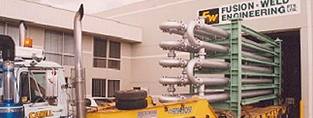
- (03) 5909 8218
- enquiry@fusionweld.com.au
australian standards and regulations for pressure vessels
August 9, 2016

A structured safety framework serves as the invisible backbone that assures optimised pressure vessel performance. In Australia, the foundations of this safe operability setup are written down in terms of regulatory guidelines. These aren't abstract laws produced by distant bureaucratic bodies, they're system-relevant rules that target essential engineering attributes.
Interpreting Australian Standards and Regulations for Pressure Vessels
We're referring to pressure variances, temperature spikes, and all of the process-oriented forces that tear at metal surfaces and weld seams. Australian standards, like any other enlightened international body, dedicate special resources towards assessing design specifications and application domains. In adhering to these exhaustively evaluated rules, let's move on to the requirements of the AS/AZ 1200 standard.
The Relatedness of Australian Safety Families
The AS/NZ standard is endorsed by the joint safety committee, thus it's regarded as an industry standard throughout the continent. On further reading, it's not sanctioned by every state, but committee approval does lend the document near universal acceptance. The parent document includes the AS/NZ 1200-2010 standard, which covers safe design practices for general-to-advanced pressure vessels.
Golden Design Requirement Regulations
The above standards are supplemented by manufacturing regulations, including the AS 4458 document, a regulatory guideline package that details material supply and welding techniques, among other manufacturing disciplines. We could go on to list a long line of Australian Standards at this point, but all we're really doing is underscoring the need for this regulatory framework. In short, the rules are there to guide manufacturers through the design cycle. They never abstain from this all-encompassing governance until the pressure vessel has been properly inspected and commissioned. Even then, maintenance guidelines extend the regulations outward, which is where environmental influences enter the mix.
An Objectified Approach to Pressure Vessel Design
The environment is the next block in the safety flow chart. Manufacturing regulations have been satisfied by the commissioning stage, so the standards are outbound, headed for the application area. This could be a basic fuel depot or some advanced chemical processing unit, among many other considered applications. In essence, environmental concerns impact pressure vessel designs. Salt air corrodes out here, as do acid rainwater, so the rules must account for such parts-deteriorating influences.
When enacting Australian standards and regulations for pressure vessels, every manufacturing process is governed by this legislature. And, when production concludes so that commissioning can commence, the rules never falter. Instead, they seamlessly swing on over to conduct maintenance strategies and lifespan assessments.
Contact Details
Fusion - Weld Engineering Pty Ltd
ABN 98 068 987619
1865 Frankston Flinders Road,
Hastings, VIC 3915
Ph: (03) 5909 8218
Optimized by NetwizardSEO.com.au
Recent Posts
- Compressed Hydrogen Storage Vessels: Material Selection, Design & Australian Standards
- Welding QA/QC in Oil & Gas Pressure Vessel Fabrication – Ensuring Code Compliance
- AS1210 vs ASME VIII Pressure Vessel Code: Key Differences for Australian Projects
- Mitigating Hydrogen-Induced Cracking in Pressure Vessels: Engineering and Material Strategies
- Storage Tank Solutions Australia: Field-Erected, Prefabricated & Self-Bunded Explained
- Reducing Environmental Risks: Self-Bunded Tanks in Australian Oil & Gas Operations
- Precision in Production: How Pressure Vessels Are Manufactured for Industrial Safety
- Shell & Tube Heat Exchangers: Improve Thermal Control & Energy Recovery in Petrochemical & Pharmaceutical Plants
- In-Service Inspection for Compressed Air Receivers for Power Plant Shutdown Prevention
- Power Plant Pipe Spooling Fabrication – Get Rapid, Code-Compliant Spools Ready for Installation
- Field Erected Tanks: Safe, Reliable On-Site Fuel Storage Solutions in Australia
- Custom Pressure Vessel Fabrication for Flammable Gases
Posts 2025
- Compressed Hydrogen Storage Vessels: Material Selection, Design & Australian Standards
- Welding QA/QC in Oil & Gas Pressure Vessel Fabrication – Ensuring Code Compliance
- View all articles…
Posts 2024
- Large Process Vessels: Optimising the Design for Maximum Efficiency [2025]
- Pressure Equipment Management System Installation: Detect Equipment Faults Early
- View all articles…
Posts 2023
- Pressure Piping System Inspection: A Gift of Safety for the Holidays
- Deaerator Inspections by Fusion-Weld Engineering and How They Reduce System Downtime
- View all articles…
Posts 2022
- How Fusion Weld Keeps Up With AS-NZS ISO 9001:2008 Standard
- Boiler Equipment Safety Inspection During the Summer Season
- View all articles…
Posts 2021
- Avoid These Factors and Practices that Contribute to Sealing Damage in Pressure Vessels
- Do's And Don'ts Of Industrial Boiler Inspection And Maintenance From Fusion-Weld
- View all articles…
Posts 2020
- What are the Risks and Hazards Involved in Pressure Vessel Equipment?
- How to Know if Your Pressure Equipment Needs Repair or Replacement?
- View all articles…
Posts 2019
- Factors that Contribute to Pressure Vessel Failure
- Pressure Vessel Regulations in Australia: What are the Mandatory Requirements?
- View all articles…
Posts 2018
- Pros and Cons of Spherical vs. Cylindrical Pressure Vessels
- What are the Different Hazard Levels in Pressure Vessels?
- View all articles…
Posts 2017
- Transportable Pressure Vessels: The Importance of Inspection and Safety Checks
- Fracture Mechanics and Stress Analysis of Cracks in Pressure Vessels
- View all articles…
Posts 2016
Posts 2015
- What Are Deaerators & Feedwater Vessels?
- Precautions and Safety for Compressed Air Receiver Vessels
- View all articles…
Posts 2014
- Demonstrating In-process Inspection Procedures
- Static Grounding Practices and Standards
- View all articles…